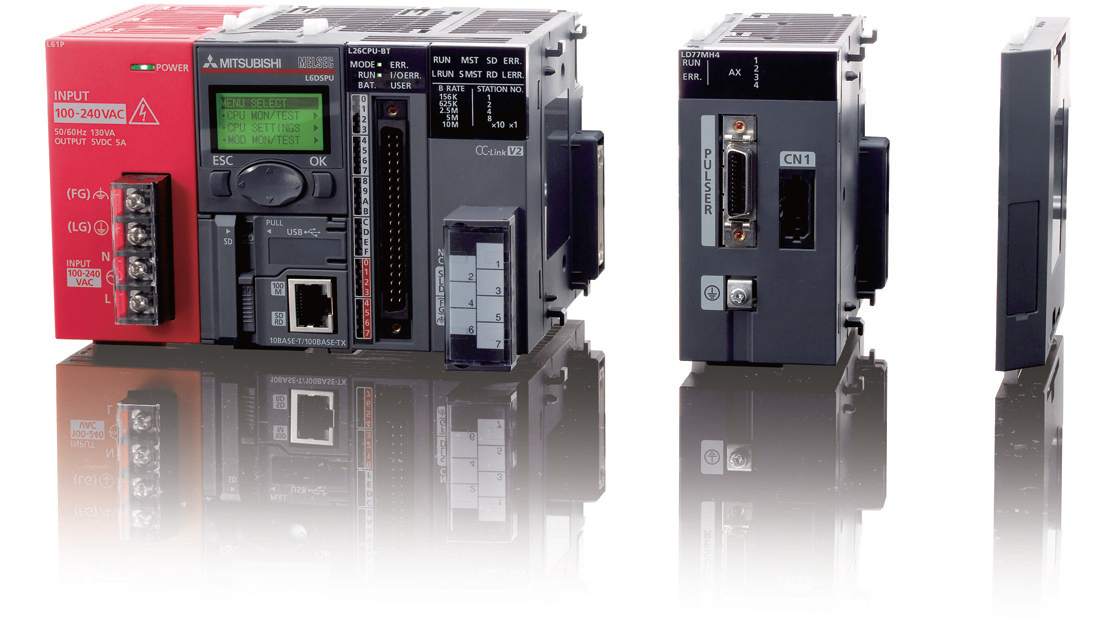

|
Edward Lowton
Editor |


|
ARTICLE
PLC bridges a gap
25 January 2013
The new L series PLC from Mitsubishi Electric has been designed to provide the functions and capabilities necessary for today's demanding machine automation requirements in a compact, modular, rack-free package. Brid

The new L series PLC from Mitsubishi
Electric has been designed to
provide the functions and
capabilities necessary for today's
demanding machine automation
requirements in a compact, modular,
rack-free package.
Bridging the gap between the company's FX compact PLC and its iQ platform PAC, the modular controller combines much of the power of a Q series CPU, with the ease of expansion and user-centric design offered by the FX.
All the features and functions needed for sophisticated automated machines are built into the CPU as standard, minimising hardware, saving panel space and engineering costs and ensuring flexibility.
Every L series CPU provides as standard; 24 points of on board I/O, a 2-channel high speed counter, 2- axes of positioning, pulse catch and interrupt functions, Ethernet connectivity and built-in data logging.
The built-in positioning function has a start time of just 30µs, with a maximum high-speed output of 200k pulses/sec, and features such as Scurve acceleration and deceleration, meeting the needs of complex machine positioning applications.
The built-in data logging function provides a simple means of collating OEE (overall equipment efficiency) data, energy monitoring, sequencing and production traceability, with the facility to store this data to SD memory card using the integral memory card slot. The same slot also makes it easy to back up or load the CPU programs and parameters.
A built-in Ethernet communications port provides a simple interface to the enterprise level, seamless peer to peer communications and direct connectivity to devices such as HMIs.
Bridging the gap between the company's FX compact PLC and its iQ platform PAC, the modular controller combines much of the power of a Q series CPU, with the ease of expansion and user-centric design offered by the FX.
All the features and functions needed for sophisticated automated machines are built into the CPU as standard, minimising hardware, saving panel space and engineering costs and ensuring flexibility.
Every L series CPU provides as standard; 24 points of on board I/O, a 2-channel high speed counter, 2- axes of positioning, pulse catch and interrupt functions, Ethernet connectivity and built-in data logging.
The built-in positioning function has a start time of just 30µs, with a maximum high-speed output of 200k pulses/sec, and features such as Scurve acceleration and deceleration, meeting the needs of complex machine positioning applications.
The built-in data logging function provides a simple means of collating OEE (overall equipment efficiency) data, energy monitoring, sequencing and production traceability, with the facility to store this data to SD memory card using the integral memory card slot. The same slot also makes it easy to back up or load the CPU programs and parameters.
A built-in Ethernet communications port provides a simple interface to the enterprise level, seamless peer to peer communications and direct connectivity to devices such as HMIs.
MORE FROM THIS COMPANY
- What will the SME manufacturing landscape look like post COVID-19?
- Cyber security: Journey not destination
- Energy saving in mines and quarries
- Mitsubishi Electric enhances its life cycle services portfolio in collaboration with Tekgem UK
- Integrated display
- Leveraging the power of data
- Small and mighty: Mitsubishi Electric introduces new compact PLC
- Drives: Delivering key benefits
- Mobile robots: Moving manufacturing forward
- AI boosting maintenance management for robots
RELATED ARTICLES
- No related articles listed
OTHER ARTICLES IN THIS SECTION

















